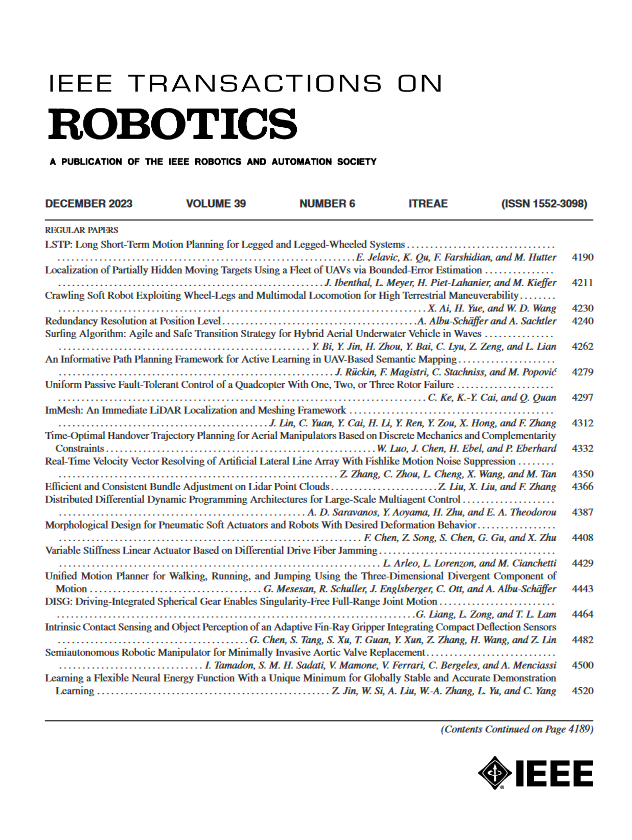动力膝踝假体的双侧活动识别和持续适应
IF 10.5
1区 计算机科学
Q1 ROBOTICS
引用次数: 0
摘要
为了使动力假肢在日常生活中可行,它们需要一个不仅准确而且易于理解和使用的活动分类系统。然而,在现实世界中结合多种活动模式,通常需要高维特征空间和每次过渡时腿部的限制。本文通过将坐/站转换和变倾斜行走委托给中级控制器来解决这些挑战,有效地将分类空间减少到具有易于区分特征的四个状态。我们使用下肢运动学特征、地面接触和倾斜度以及与超声波传感器的环境距离,为假肢引导和完整引导(即双侧)转换实现了简单的启发式规则。两名使用动力膝关节-踝关节假体的经股截肢患者在自定节奏和快节奏/疲劳条件下的双侧过渡准确率均为99.2%,由于备份逻辑或用户提示重置,恢复率为100%。倾斜估计器使假肢能够在水平和倾斜表面之间连续适应,而不需要明确的分类。这些结果和室外多地形演示表明,简单直接的转换逻辑可以使动力假肢在广泛的日常活动中可靠地使用。本文章由计算机程序翻译,如有差异,请以英文原文为准。
Ambilateral Activity Recognition and Continuous Adaptation With a Powered Knee-Ankle Prosthesis
For powered prosthetic legs to be viable in everyday situations, they require an activity classification system that is not only accurate but also straightforward to understand and use. However, incorporating the numerous activity modes in real-world ambulation often requires high-dimensional feature spaces and restrictions on the leg leading each transition. This article addresses these challenges by delegating sit/stand transitions and variable-incline walking to the mid-level controller, effectively reducing the classification space to four states with easily distinguishable features. We implement simple heuristic rules for both prosthetic-led and intact-led (i.e., ambilateral) transitions, using lower limb kinematic features, ground contact and inclination, and environmental distance from an ultrasonic sensor. Two transfemoral amputee subjects using a powered knee-ankle prosthesis demonstrated an ambilateral transition accuracy of 99.2% under both self-paced and rapid-paced/fatiguing conditions, with a 100% recovery rate due to backup logic or user-cued resets. The incline estimator enabled the prosthesis to continuously adapt between level and inclined surfaces without explicit classification. These results and an outdoor multiterrain demonstration indicate that simple and straightforward transition logic can enable powered prosthetic legs to be used reliably across a broad array of daily activities.
求助全文
通过发布文献求助,成功后即可免费获取论文全文。
去求助
来源期刊

IEEE Transactions on Robotics
工程技术-机器人学
CiteScore
14.90
自引率
5.10%
发文量
259
审稿时长
6.0 months
期刊介绍:
The IEEE Transactions on Robotics (T-RO) is dedicated to publishing fundamental papers covering all facets of robotics, drawing on interdisciplinary approaches from computer science, control systems, electrical engineering, mathematics, mechanical engineering, and beyond. From industrial applications to service and personal assistants, surgical operations to space, underwater, and remote exploration, robots and intelligent machines play pivotal roles across various domains, including entertainment, safety, search and rescue, military applications, agriculture, and intelligent vehicles.
Special emphasis is placed on intelligent machines and systems designed for unstructured environments, where a significant portion of the environment remains unknown and beyond direct sensing or control.
 求助内容:
求助内容: 应助结果提醒方式:
应助结果提醒方式:


